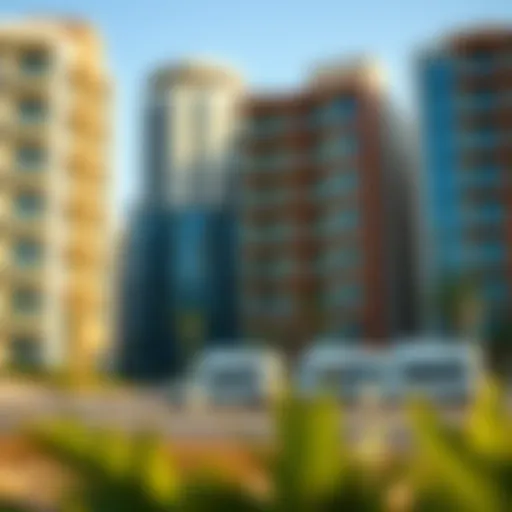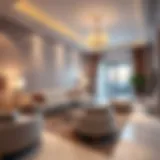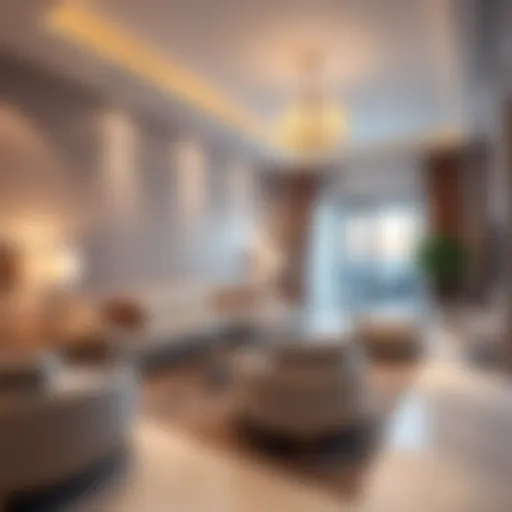Exploring Luxurious Palace Residence Floor Plans in Dubai
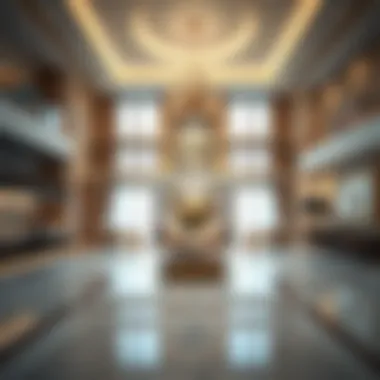
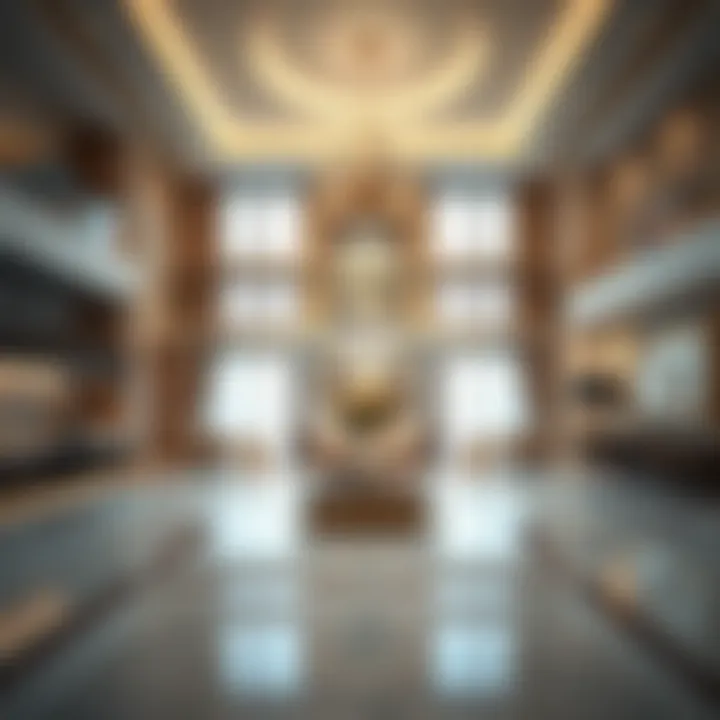
Intro
Dubai's real estate scene is not just booming; it’s bursting at the seams with innovation and luxury. At its heart lies a unique aspect of real estate that stands out—palace residence floor plans. These floor plans don’t simply serve as blueprints for construction; they embody a lifestyle marked by opulence and grandeur. Understanding these intricate designs can open doors for discerning buyers and investors alike.
The appeal of palace residences can be attributed to their extravagant designs and personalized layouts. Unlike typical apartments or villas, these homes offer more than just spacious living; they are a statement of prestige and sophistication, catering to those who aspire for something beyond the ordinary. Through this article, we will delve into how these architectural masterpieces influence lifestyle, investment opportunities, and overall market trends.
With Dubai’s real estate market continually evolving, those interested in purchasing or investing in such properties need to keep their fingers on the current pulse of architectural developments. This exploration is designed not just to enlighten but also to provide a comprehensive view of how the unique features of palace residences resonate with the needs and aspirations of a high-end clientele.
Intro to Palace Residences
In the ever-evolving landscape of luxury real estate, palace residences in Dubai emerge as both a statement of opulence and a reflection of architectural prowess. These homes are not just places to live; they cultivate a lifestyle drenched in elegance, exclusivity, and cultural significance. Understanding this segment holds paramount importance for discerning buyers, investors, and real estate professionals alike. This section lays the groundwork for grasping the nuances that define palace residences, offering insights that resonate with those seeking not just property, but a piece of art and history.
Defining Palace Residences
A palace residence transcends traditional living spaces. In the context of Dubai, such properties boast grand scales, intricate designs, and bespoke features that cater to an upscale lifestyle. Typically, these residences come outfitted with luxurious amenities, sprawling gardens, and cutting-edge technology that ensure convenience alongside comfort.
For instance, think about a palace residence that features an expansive foyer leading into a grand hall with vaulted ceilings adorned with crystal chandeliers. This functionality goes beyond aesthetics; it embodies the social standing and the cultural richness of the area.
Key characteristics of palace residences often include:
- Spacious Floor Plans: Designed to accommodate lavish gatherings and family life.
- Elegant Finishes: High-end materials and finishes that reflect discerning taste.
- Multiple Function Areas: Separate spaces for leisure, entertainment, and formal gatherings.
In essence, these residences serve as a sanctuary that offers more than mere shelter; they provide a lifestyle statement defined by luxury and exclusivity.
Historical Context and Evolution
To fully appreciate palace residences in Dubai, one must consider their historical context and evolution. Historically, the concept of a palace was reserved for royalty and those of high social standing. In Dubai, as the city evolved from a modest fishing village to a global metropolis, the notion of luxury took on new dimensions.
The early structures in Dubai reflected basic needs and served functional purposes. As wealth flowed into the Gulf region, primarily due to oil revenues, the architectural landscape began shifting dramatically. Inspired by various influences, from Islamic architecture to contemporary designs, palace residences started incorporating unique elements, combining tradition with modern luxury.
A few notable trends in the evolution of palace residences include:
- Incorporation of Technology: The shift towards smart homes that blend convenience with elegance.
- Sustainability: Increased focus on environmentally friendly materials and energy-efficient designs.
- Cultural Reflections: Palatial designs that tell stories of the Emirates’ rich heritage while catering to contemporary lifestyles.
From their historical roots to their current status as luxurious dwellings, palace residences continue to evolve. They embody the spirit of a region that embraces progress while respecting its rich cultural tapestry.
"The transformation of residential spaces into palatial homes illustrates not only a change in wealth but a tangible shift in lifestyle and identity within the UAE."
In the following sections, this article will delve into essential elements of these residences, their architectural styles, and how they cater to both private and public living. Understanding each aspect is vital for those looking to invest or reside in this unique segment of Dubai's real estate market.
Essential Elements of Floor Plans
Understanding the fundamental components that make up the floor plans of palace residences is essential to grasping their opulent nature. These elements go beyond mere aesthetics; they serve as the backbone of luxury living, providing both functionality and a lavish lifestyle. When considering a purchase in this high-end market, a buyer must appreciate how these aspects coalesce to shape an exceptional living experience.
Understanding Spatial Layout
When it comes to luxury residences, the spatial layout is a defining feature. It's like the heart of a palace, dictating the flow and functionality of the entire space. Consider how rooms connect to one another—a well-planned layout fosters both intimacy and elegance, allowing for seamless movement between private quarters and social areas.
In palace residences, layouts often differentiate between formal and informal spaces, catering to a variety of occasions. For instance, the grand foyer typically flows into spacious living rooms, which may connect to dining areas designed for entertaining large groups. A buyer should notice how these areas are proportioned and situated. They must ask themselves:
- Does this layout promote a natural flow?
- Are there sufficient spaces for social gatherings?
- How do sight lines enhance the overall ambiance?
Effective spatial layouts in palace residences do more than simply please the eye; they enhance the lifestyle of the occupants. A public space designed for gala nights juxtaposed with cozy corners for quiet reflection reflects an understanding of the duality of luxury living.
Key Features of Palace Floor Plans
Key features of palace floor plans distinguish them from standard residences, making them a coveted asset in the luxury market. These features enhance not only the aesthetic appeal but also the functionality of the spaces.
Among the hallmarks of palace floor plans, high ceilings often stand out, creating an atmosphere of grandeur. They also allow for elaborate chandeliers or architectural elements like crown molding, enriching visual interest. Here are other prominent features worth considering:
- Customizable spaces: Many modern layouts feature multi-functional rooms, allowing owners to easily adapt areas for specific purposes, such as a home office or a personalized gym.
- Integrated indoor and outdoor spaces: Bi-fold or sliding doors offer a seamless transition to outdoor gardens or terraces, emphasizing the region's preference for alfresco living.
- Grand entrances and staircases: These elements are critical as they provide a dramatic first impression. A well-crafted staircase can be a sculptural focal point, enhancing the overall luxury experience.
Architectural Styles and Their Impact
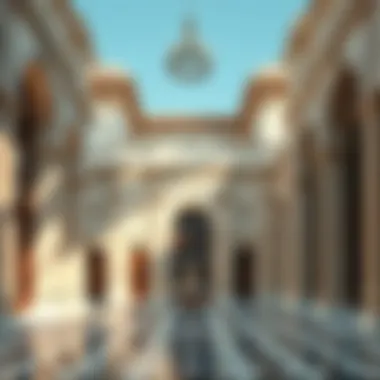
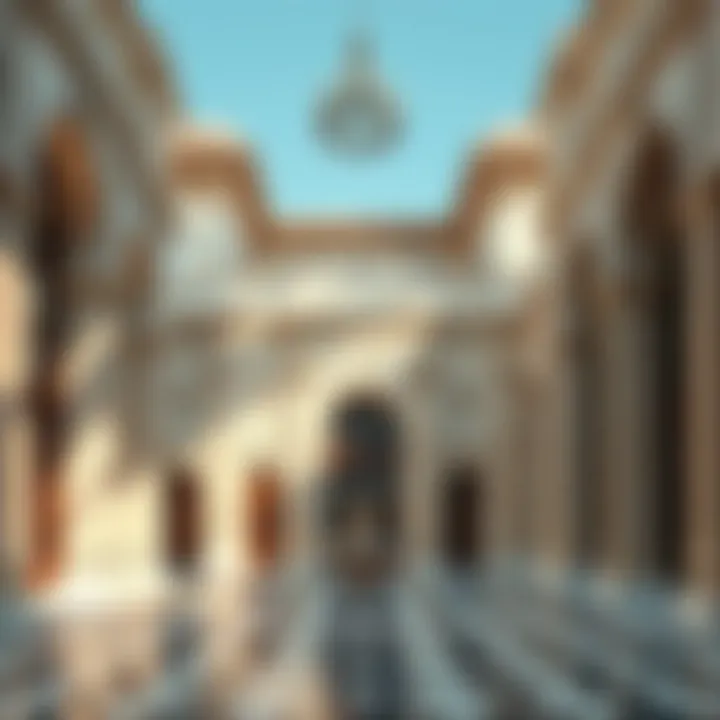
The architectural style of a palace residence in Dubai holds considerable weight in defining the overall character and aesthetic appeal of the property. It serves as a reflection of cultural narratives and social status while influencing the buyer’s lifestyle and investment choices. As the skyline of Dubai has continued to evolve, architectural styles have adapted, infusing both traditional and contemporary elements into the design of these luxurious residences. This section elucidates the paramount significance of architectural styles and how they impact the perception and value of palace residences.
Traditional vs. Contemporary Designs
In essence, traditional designs often echo the architectural grandeur seen in the Emirati heritage, frequently employing intricate detailing reminiscent of Islamic art. These residences tend to feature expansive courtyards, decorative tile work, and ornate arches. The elements come together to not only provide beauty but also a sense of history and connection to the past.
On the flip side, contemporary designs embrace modernism, emphasizing minimalism and functionality without sacrificing elegance. Large glass facades and open spaces define these structures, allowing for natural light to pour in, creating a serene living environment. Here are some distinguishing features between the two styles:
- Traditional Designs:
- Contemporary Designs:
- Rich ornamentation with tile and mosaic patterns
- Courtyards designed for social gatherings
- Use of stone and wood showcasing craftsmanship
- Sleek lines with a focus on spaciousness
- Integration of smart home technology
- Use of sustainable materials to address eco-friendly concerns
Choosing between traditional and contemporary designs ultimately boils down to personal taste and lifestyle requirements. For investors, understanding these preferences can guide decisions on property acquisition, ensuring alignment with market demand.
Cultural Influences on Design
When examining palace residences in Dubai, it's impossible to ignore the significant cultural influences that shape architectural decisions. The Emirate’s diverse population marries various traditions, creating a melting pot of design philosophies. Cultural influences often manifest in various ways, as we explore below:
- Islamic Architecture:
Foundational to many palace residences, this style emphasizes geometric patterns and symmetry, portraying religious significance and aesthetic appeal. - International Trends:
With Dubai being a global city, there are palpable international influences that seep into local architecture. Designs may adapt features from Western styles while maintaining local sensibilities. - Environmental Context:
Local climate can greatly influence design decisions. For instance, the use of overhangs and shading elements is common in traditional residences to combat heat, reflecting a practical approach rooted in cultural necessity.
Understanding how cultural influences intertwine with architectural styles allows buyers and investors to appreciate the nuances in design choices. These details may not only enhance the livability of these palatial spaces but also contribute significantly to their market value in a diverse and competitive real estate landscape.
"The intersection of tradition and modernity creates a unique architectural narrative that defines the essence of life in Dubai."
For those keen on investing in the luxury sector, recognizing these elements in palace residences can undeniably elevate one’s appreciation of property values and community dynamics.
Functional Areas Within Palace Residences
When delving into the opulent world of palace residences in Dubai, understanding the functional areas is paramount. These areas are not just assigned spaces; they are the very backbone of luxurious living, offering a blend of practicality and prestige that defines the lifestyle of elite residents. Functional areas within these grand structures serve to differentiate between the everyday and the extraordinary. They cater to the multifaceted needs of their inhabitants, combining comfort with lavishness.
Living Spaces and Their Arrangement
In any palace residence, the living space is the heart of the home. Arrangements vary significantly based on personal taste and the intended use of space. A traditional layout might offer a sweeping grand hall that flows into multiple reception areas, while a contemporary design could favor open-plan living, merging kitchen and dining into one expansive area.
- Functionality: The arrangement of these living spaces is designed to maximize light and openness, promoting a lively atmosphere while fostering social interactions. High ceilings often create a sense of grandeur, while strategically placed windows invite natural light, enhancing the inviting ambiance.
- Diversity: You might find various textures in furnishings and decorative pieces, reflecting modern minimalism or rich traditional styles. The living spaces often come equipped with technologies that allow for personalized control over lighting and climate — a subtle nod to comfort amid elegance.
Private and Entertainment Areas
The distinction between private and entertaining spaces is crucial in palace residences. On one hand, private areas, such as bedrooms and study rooms, are sanctuaries designed for tranquility and repose. On the other hand, entertainment zones, including media rooms and lounges, are geared towards socializing and creating memorable experiences.
- Private Areas: Bedrooms are typically expansive, featuring en-suite facilities and plush walk-in closets. These spaces emphasize privacy and relaxation, often adorned with calming color schemes and luxurious materials. Think high-thread-count sheets and custom furnishings.
- Entertainment Areas: These are where the magic happens — a place for gatherings, celebrations, or quiet movie nights. Sophisticated sound systems and clever layouts facilitate both casual get-togethers and formal receptions. It’s common for these areas to strike a balance between style and comfort, ensuring that every gathering can flow seamlessly.
Outdoor Spaces and Gardens
Outdoor areas in palace residences are not mere adjuncts but vital extensions of living spaces. Gardens, patios, and balconies provide a serene escape from the bustle of urban life, often landscaped to create an oasis of tranquility.
- Landscaping Features: Many residences boast tropical gardens, elaborate water features, and artistic sculptures that offer visual pleasures while promoting relaxation. A carefully tended garden might even include opportunities for growing herbs or a small vegetable patch.
- Functionality and Aesthetics: These outdoor spaces are designed not only for aesthetic appeal but for utility as well. Outdoor kitchens and entertaining areas make alfresco dining a breeze. The thoughtful integration of lighting allows enjoyment well into the evening, creating a warm, inviting environment under the stars.
In essence, the functional areas within palace residences reflect a synthesis of style and function. The thoughtfulness in design speaks volumes about the lifestyles of those who inhabit these splendid spaces.
Material Choices and Their Significance
In the realm of palace residences, particularly in opulent cities like Dubai, the choice of materials underscores the distinction between mere housing and luxurious living. Each material has its story, its texture, and its resonance with the overall aesthetic and functional vision of the residence. From the sumptuous feel of marble flooring to the sleekness of modern glass facades, these selections are not just about appearance—they are foundational to durability, energy efficiency, and even the broader environmental impact of the buildings.
Common Materials in Palace Construction
When delving into the specifics of luxury palace construction, several materials stand out:
- Marble: Often called the king of building materials, marble emits an air of sophistication. Predominantly sourced from Italian quarries, its unique patterns ensure that no two spaces appear the same. It's not uncommon to see it adorning grand hallways or lavish bathrooms in palace residences.
- Wood: The use of hardwoods like teak and mahogany imparts warmth and elegance. These woods not only look beautiful but also provide structural integrity and sustainability when sourced responsibly.
- Glass: With advancements in technology, glass has emerged as a prevalent choice, offering uninterrupted views and fostering a connection with the outside world. Low-E glass can also help improve energy efficiency, allowing natural light while minimizing heat gain.
- Concrete: While it may seem utilitarian, innovative textures and finishes can transform concrete into a statement material. Reinforced concrete structures provide the backbone of many palace designs, especially in multi-story constructions.
Each of these materials serves a dual purpose: enhancing aesthetics while ensuring functionality. Whether building towering spires that gleam in the sun or intimate spaces that invite relaxation, materials are at the heart of the architectural narrative.
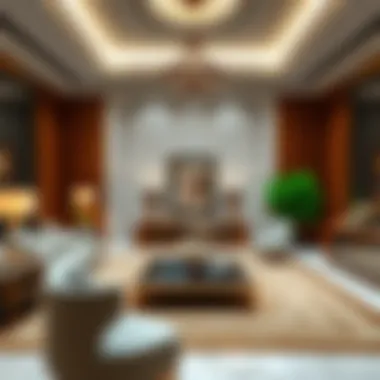
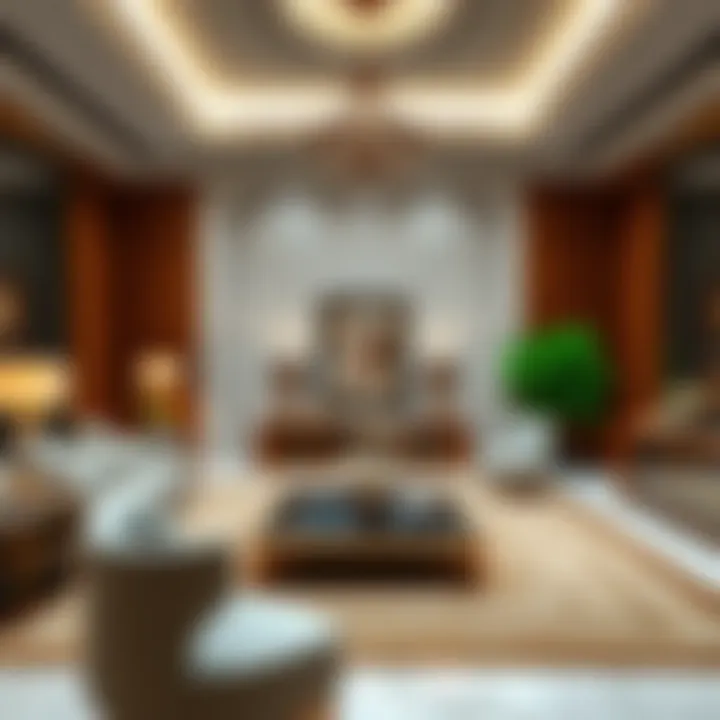
Sustainability Considerations
With the increasing emphasis on environmental stewardship, the sustainability of materials is becoming paramount in luxury construction. Here's how:
- Eco-Friendly Options: As investors and buyers become more environmentally conscious, the use of recycled materials and sustainably sourced wood is gaining traction. For instance, reclaimed wood can add character while minimizing deforestation.
- Energy Efficiency: Materials that enhance energy efficiency, such as advanced insulation and energy-efficient glazing, can significantly reduce the carbon footprint of a palace residence. This approach leads to lower energy bills and promotes conservation without compromising luxury.
- Water Conservation: The integration of sustainable materials often goes hand in hand with innovative plumbing solutions, featuring water-recycling systems and drought-resistant landscaping. Such designs not only conserve water but also amplify the palace's lush outdoor spaces.
By emphasizing sustainable design, palace residences not only enhance personal comfort but also contribute positively to the broader environment.
"Investing in sustainable materials today means enjoying the luxury of tomorrow, with a clear conscience."
In summary, the choices of materials in palace constructions in Dubai go beyond the surface, revealing layers of significance that impact longevity, environmental stewardship, and aesthetic pleasure. As the market trends shift towards sustainability and luxury, understanding these material choices will be vital for discerning buyers and investors alike.
Technological Integration in Modern Floor Plans
In the contemporary landscape of luxury real estate, particularly in Dubai, the integration of technology into palace residence floor plans has become more than just a trend; it is a necessity. With rapid advancements in technological capabilities, discerning buyers are looking for homes that not just provide shelter but also elevate their lifestyle through convenience, security, and innovation. The elements involved in this integration vary widely, focusing on everything from smart home functionalities to comprehensive security systems.
Smart Home Features
One can't help but notice the growing prominence of smart home technology in the designs of modern palace residences. Features like automated lighting, climate control, and smart entertainment systems are now commonplace, blending seamlessly into the architectural layout. For example, having a fully integrated smart home system allows residents to use their smartphones or voice commands to manage household functions, making everyday tasks less cumbersome.
Moreover, these smart systems can contribute significantly to energy efficiency. Residents can monitor energy consumption easily, ensuring they are not just living in luxury but also maintaining a responsible lifestyle.
Key elements typically found in smart homes include:
- Automated Lighting: Lights that adjust according to the time of day or occupancy.
- Smart Thermostats: Devices that learn your preferences to optimize heating and cooling.
- Home Automation Hubs: Central systems that connect all smart devices for cohesive operation.
- Voice Assistants: Devices like Amazon Echo or Google Home that serve as command centers for managing various activities.
This technology not only enhances convenience but also significantly raises the overall value of the properties. Buyers looking to invest in luxury residences often ask about these integrations as a benchmark of sophistication.
Security Considerations
As important as comfort and convenience, security remains a paramount concern for homeowners of palace residences. The emphasis on safety in modern floor plans is evident through the incorporation of various high-tech solutions. From surveillance cameras to biometric locks, these measures protect not only the physical property but also the occupants within.
Integrated security features might include:
- Smart Locks: Keyless entry systems that allow for remote locking and unlocking.
- CCTV Systems: Cameras that provide live feeds to smartphones, ensuring homeowners can monitor their property from anywhere.
- Motion Sensors: Devices that alert residents or authorities to movement in restricted areas.
- Alarm Systems: Modern alarms that can be monitored remotely and linked to local law enforcement.
The confluence of luxury and security can significantly sway buyer decisions today. Understanding these layers of integration helps prospective owners gauge not only the livability of a space but also the safety it affords.
In a city like Dubai, where security is often a hallmark of premium living, the modernization of floor plans through technological advancements aligns well with buyer expectations. Thus, developers who recognize this link between technology and luxury are more likely to see successful investments.
Investing in palace residences becomes about more than just acquiring property but ensuring that the home meets the highest standards of innovation while also catering to the safety and security of its inhabitants.
Market Trends in Luxury Residences
In the swiftly evolving landscape of real estate, paying attention to market trends in luxury residences is crucial. The dynamics of this sector offer insights not only into consumer preferences but also into broader economic indicators. Here in Dubai, where opulence is synonymous with everyday life, luxury properties are often at the forefront of innovation and design evolution.
Understanding these trends helps stakeholders like investors, homebuyers, agents, and developers make informed decisions. They provide a reflection of not just housing needs, but also of cultural shifts and the economic climate. With Dubai's luxury market being a melting pot of influences, keeping a finger on the pulse is essential for anyone keen on navigating this lucrative environment.
Notably, as the city continues its trajectory of growth, trends can signal emerging opportunities or potential pitfalls. For example, the rise in demand for sustainable living spaces reflects a greater societal awareness regarding environmental impact, shaping how luxury residences are marketed and developed. Additionally, the gravitation towards smart home technology is not merely a trend, but a fundamental shift that speaks volumes about modern lifestyles.
Current Market Insights
The luxury residence market in Dubai is currently thriving, bolstered by a steady influx of international buyers and innovative architectural marvels that redefine the skyline. Recent data indicates that high-net-worth individuals are increasingly investing in properties that offer not just living space, but a complete lifestyle experience, marking a significant shift in buyer motivations.
- Diverse Portfolio: There has been an uptick in the demand for properties offering something unique. Beyond traditional luxury, buyers are looking for design elements that reflect their lifestyles, humility, and sophistication.
- Location Matters: Proximity to landmarks and social amenities remains paramount. Developments in areas like Palm Jumeirah and Downtown Dubai continue to attract affluent individuals who want access to both luxury and convenience.
- Investment Activity: Increased investment from overseas buyers amidst the UAE's favorable taxation policies is helping propel the market to new heights. Be it expatriates or foreign nationals, the appeal of Dubai's lifestyle is hard to resist.
"Real estate is about location, but luxury real estate is about aspiration."
These insights not only pinpoint current preferences but also uncover future possibilities that are ripe for exploration. As luxury buyers increasingly seek uniqueness in their purchases, understanding these trends becomes imperative for anyone engaging in the market.
Investment Potential of Palace Residences
The allure of palace residences extends beyond just aesthetics; they represent sound investment potential in the luxury real estate market. Properties of this caliber often retain their value due to their exclusive nature and the prestige attached to them. Buyers today are not solely searching for a home; they are investing in a luxury lifestyle that can offer significant financial returns.
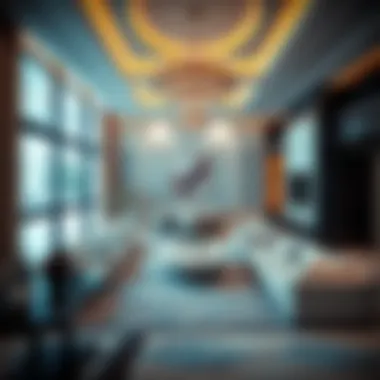
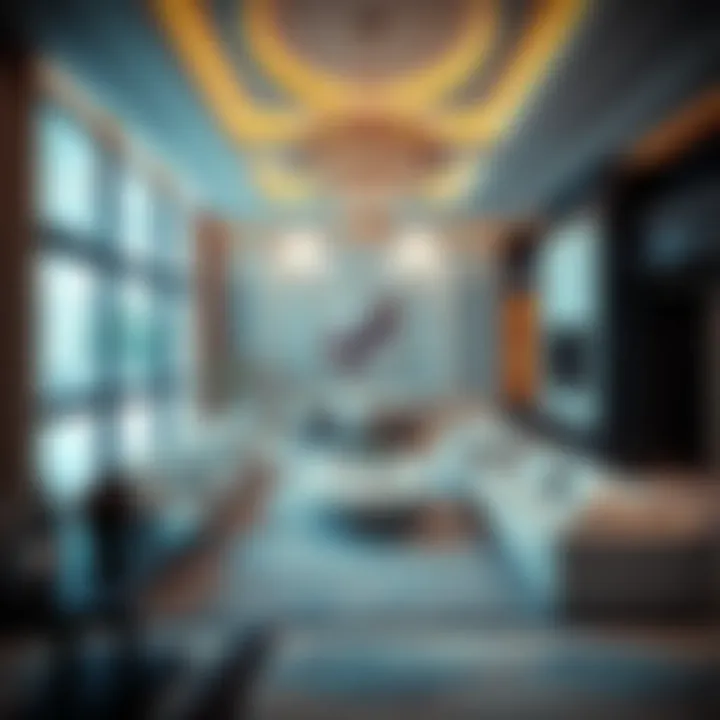
Several factors underscore the investment viability of palace residences:
- High Demand and Low Supply: The limited availability of palace-type residences creates a scarcity, allowing property values to appreciate over time. Investors recognize that a unique property is not just a home, but an opportunity.
- Catering to an Elite Clientele: The targeting of ultra-high-net-worth individuals ensures that there is always a segment willing to invest heavily in opulent living arrangements.
- Opportunities for Generating Income: Many owners opt to rent out their palace-style properties when not in use, creating a potential revenue stream. Short-term rentals can be particularly lucrative in the tourist hotspot that is Dubai.
As luxury market dynamics shift and evolve, insightful investors will be keeping an eye on palace residences as prime assets that hold the promise of longevity and financial gain.
For more detailed statistics and analysis, you can check out resources such as Knight Frank and Savills, which provide comprehensive insights into luxury real estate trends.
Regulatory Considerations for Buyers
When delving into the splendid world of palace residences in Dubai, it is pivotal for potential buyers to understand the regulatory landscape surrounding luxury real estate. In a market known for its dazzling properties and expansive skyline, grasping these regulations can make the difference between a sound investment and a costly misstep. This section will dissect the legal intricacies that shape the buying process and offer crucial insights for navigating these waters effectively.
Legal Aspects of Buying Luxury Properties
The legal framework governing luxury property purchases in Dubai involves a multitude of factors that buyers must consider. First, there are various ownership structures, including freehold and leasehold arrangements. Freehold properties allow you full ownership of the land and the property itself—a coveted status that appeals to many investors. In contrast, leasehold properties limit ownership to a specified period, typically 99 years, making them less desirable but still common in certain developments.
"Understanding ownership types is paramount for any prospective buyer, especially in an evolving market like Dubai's."
Licensing is another key component. Buyers should ensure that the property is registered with the Dubai Land Department. This not only serves as proof of ownership but also ensures that the property adheres to local zoning laws and construction regulations. Buyers must be wary of unlicensed developments as these may harbor legal issues down the line.
Moreover, understanding the role of the Real Estate Regulatory Agency (RERA) is essential. This body sets foundational documentation requirements, protects buyers' rights, and ensures fair practices are followed in real estate transactions. Familiarizing oneself with RERA regulations can prevent pitfalls like undisclosed property taxes or hidden fees.
In terms of financing, foreign buyers often face different regulations. Certain banks impose stricter criteria on international investors. Thus, scrutinizing mortgage terms and interest rates can save buyers from future financial strain.
Navigating Local Real Estate Laws
Navigating the legal landscape of Dubai's real estate market can be intricate, especially for foreign buyers. It begins with recognizing that Dubai offers a welcoming environment for international investors, but that comes with specific requirements. For instance, non-residents must adhere to Foreign Ownership Laws, which limit property acquisitions in certain areas. Therefore, it's crucial to conduct thorough research or consult with professionals who are well-versed in local laws.
The process generally involves multiple steps:
- Property Identification: Begin with thorough market research. Knowing which neighborhoods allow foreign ownership is critical.
- Legal Advisors: Engaging a local attorney can streamline the complex buying process. They can assist in understanding contracts, associated fees, and other legal obligations.
- Contracts and Due Diligence: Contractual agreements demand close attention. Buyers should engage in due diligence to ensure there are no disqualifying clauses that could impact ownership.
Furthermore, while locating residential developments in Dubai, familiarize yourself with the Master Community Declaration, which outlines the restrictions and obligations for property owners. Awareness of these stipulations can save considerable time and trouble during and after the purchase.
By considering these regulatory aspects, buyers not only protect their investments but also enhance their experience in securing a palace residence in one of the world's most affluent cities. Through informed decision-making, they can navigate the stunning yet complex realm of Dubai's luxurious real estate market.
Case Studies of Notable Palace Residences
Examining case studies of notable palace residences sheds light on the trends that define luxury living in Dubai. These examples serve not only as benchmarks of architectural prowess but also as reflections of the social dynamics and lifestyle preferences of their inhabitants. By analyzing specific properties, potential buyers and investors can glean insights into what makes a residence not just livable, but extraordinary. These case studies provide a tangible understanding of how layout, materials, and technology coalesce to create high-end living spaces.
Iconic Examples in Dubai
Dubai is home to several distinguished palace residences that exemplify opulence and innovation. The Bulgari Resort and Palace, for instance, combines Mediterranean architecture with a contemporary twist, showcasing spacious layouts that prioritize both aesthetic appeal and functionality. With expansive terraces that overlook crystal-clear waters, this project illustrates how outdoor living can be seamlessly integrated into the overall floor plan.
Then, there’s the Emirates Hills Villa, which is a testament to grandeur—each room designed with intricate detail, high ceilings, and open spaces that promote a sense of freedom. Its thoughtful design captures the importance of community and privacy, enabling both lavish entertaining and intimate family gatherings.
Another noteworthy mention is the Majestic Al Habtoor City residences, where the elegance of classical motifs meets cutting-edge technology. These homes feature smart home systems, integrated security measures, and eco-friendly materials, reflecting the shift towards sustainability without sacrificing luxury. Here, the emphasis is on spacious sanctuaries that cater to the needs of a modern affluent lifestyle.
Comparative Analysis of Designs
When comparing designs across these iconic residences, one can observe distinct threads that tie luxury living together while also note diversities based on cultural influences and investor expectations.
- Layout Organization: Traditional designs often feature ornate entryways leading to expansive family areas, while modern designs opt for a more fluid layout that encourages interaction among spaces.
- Material Usage: While many palatial homes employ lavish marble and intricate woodwork, others showcase a preference for minimalist materials like glass and steel, promoting a lighter aesthetic.
- Integration with Nature: A common theme across these designs is the integration of outdoor spaces—balconies, gardens, and pools are not just elements of luxury but essential parts of the overall residential experience. The surrounding environment is often reflected in the architectural choice, allowing for both privacy and a connection to nature.
Through case studies, investors can better understand these varied design philosophies and how they align with market trends, aiding in informed decision-making. The intersection of tradition and modernity found within these residences ultimately serves to redefine the very notion of luxury living in Dubai.
Epilogue and Future Perspectives
In wrapping up this exploration of palace residence floor plans in Dubai, it becomes clear that understanding these architectural designs is paramount for anyone looking to invest in luxury living. The considerations involved in designing such grand spaces go beyond aesthetics; they extend into functionality, cultural significance, and the lifestyle they promote. Luxury isn’t merely about opulence; it intertwines with practicality, making it essential for potential homeowners and investors to grasp the intricacies of these floor plans.
As the landscape of luxury real estate evolves, several specific elements stand out as particularly significant. For instance, many palace residences now strive to harmonize indoor and outdoor spaces, creating a seamless flow that embodies luxury living. Additionally, the emphasis on sustainability in building materials demonstrates a growing trend toward environmentally conscious investments. This shift not only aligns with global eco-initiatives but also reflects a change in consumer preferences.
Summarizing Key Takeaways
- Emphasis on Functionality: Palace residences are designed to be more than just visually striking; they serve a purpose that often includes accommodating large families and entertaining guests.
- Integration of Modern Technology: Smart home features have become a non-negotiable aspect, ensuring safety and convenience, from energy efficiency to security systems.
- Cultural Significance: Architectural elements are often blended with local culture, resulting in homes that not only stand out aesthetically but also tell a story about the region’s heritage.
- Outdoor Living: A focus on gardens and outdoor spaces not only enhances the living experience but also adds value to the property.
Looking Ahead: Future Trends in Palace Residences
The future of palace residences in Dubai is poised for exciting changes. Here are a few trends that are stealthily gaining traction:
- Increased Demand for Sustainable Homes: As awareness grows regarding climate change, buyers may increasingly seek residences that minimize their carbon footprint through energy-efficient designs and sustainable materials.
- Flexible Spaces: Future designs might feature adaptable layouts that can transform spaces based on the needs of the residents. For example, a guest suite could double as a home office when not occupied.
- Community-Oriented Living: There's a noticeable shift towards residences that incorporate communal areas, fostering a sense of community among residents in luxury settings.



